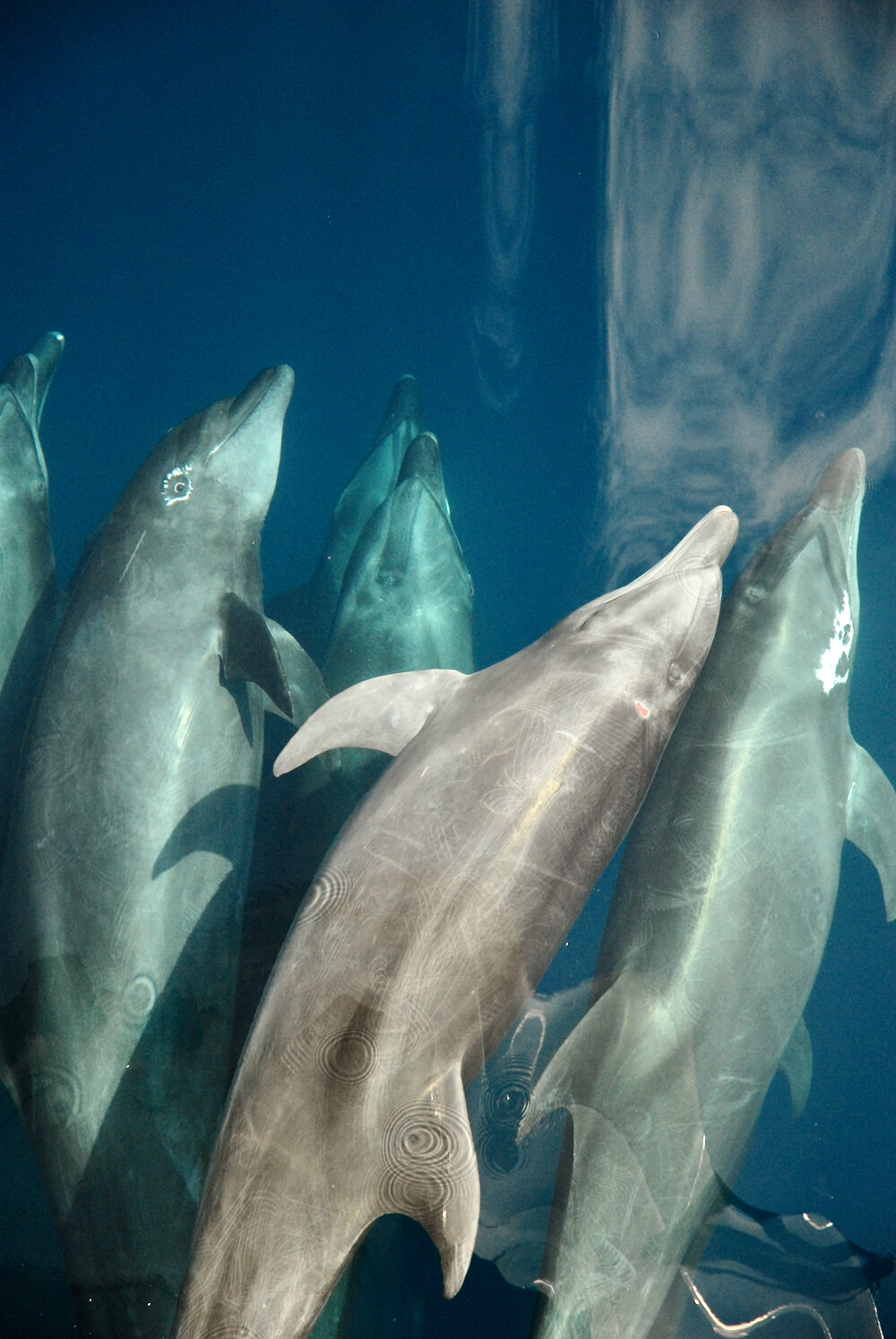Fast Asleep In The Deep
By Mary Jane Schramm
It was a long, Southeast Alaska summer’s day, with 16 hours of sunlight. From our 50 foot live-aboard research vessel, R/V Evolution anchored off Chichagof Island, we’d been using our smaller skiff to run out into Chatham Strait and sneak up to social-foraging humpback whales. They had followed schools of herring into the area, and we were documenting their unusual “bubble net” feeding behavior. Various small groups repeatedly herded fish into sumptuous underwater bait balls, then lunged upward, bursting through the surface in an explosion of gaping whale maws and herring. Finally, darkness fell, and returning to Evolution, we fell into our bunks (I shared mine–the “junk bunk”—with a biopsy crossbow).
Around midnight, a concussion shuddered the boat and rattled the anchor chain. We scrambled onto the deck to discover the cause: a sleeping whale had swum or drifted into our hull and anchor chain. “No problem; it happens,” the lead scientist reassured us as we peered at the patches of light cast by our flashlights onto the whale’s back; it slowly swam away into the darkness. “They sleep with only half their brain at a time, while the other half is awake so they can breathe; and hopefully, not drift into things. Apparently, this guy, wasn’t paying attention.” We marveled at this, and at the sounds of other, unseen whales breathing all around us. We marveled even more at the eerie, undulating green glow of the Aurora Borealis, above. The “witching hour” had become a bewitching hour.
SLEEPWALK: Like humans and other terrestrial mammals, marine mammals—seals, sea lions, walrus, dolphins, porpoises, whales, dugongs and manatees—breathe air. Unlike us, they lack the autonomic nervous system that allows us hours of uninterrupted full-brain sleep and automatic, involuntary breathing. The left and right hemispheres of cetacean (dolphins, porpoises, whales) brains function alternately, with one hemisphere awake, but its opposite eye open. That hemisphere remains alert to dangers, such as obstacles, predators, or the sound of oncoming ships. It also signals when to resurface and breathe, and in resting social groups, when to tighten formation. Meanwhile, the other hemisphere’s brain waves slow down, and it enjoys deep, restorative sleep. Then, like shift workers, they switch roles.
RIP VAN WHALE: How long do they sleep between breaths? We know that Cuvier’s beaked whales can breath-hold for over three hours during deep foraging dives, but cetacean sleeping and resting breaths are far shorter. Sperm whales enjoy 10-15 minute naps; humpbacks are known to sleep in 30 minute bouts. Hawaiian spinner dolphins may have two-hour sessions. Some dolphins feed at night, too, on deepwater prey such as squids that only rise from the depths after sundown; this midnight snacking may form a good part of these dolphins’ diet.
ROCKED TO SLEEP . . . on the bosom of the deep: No one is sure where the humpbacks and blue whales that feed in our North-central California sanctuaries bunk down. Is there a favored “sleeping grounds” somewhere offshore, away from noisy, dangerous shipping lanes and busy ports? Our local baleen (filter-feeding) whales don’t form close knit social groups, so it could be a matter of individual preference. But toothed whales, such as sperm whales, beaked whales, dolphins and porpoises are highly social and may form sleeping and resting groups. Sometimes they drop down to the sea floor, or rest at or near the surface; sperm whale may hang vertically in the water column. Some cetaceans swim in slow, repetitive patterns. Sperm whales are also seen “logging” motionless at the surface, lined up several abreast, or individually.
SLOWING FOR SAFETY: With our abundance of whales, NOAA’s Greater Farallones and Cordell Bank national marine sanctuaries have implemented a Vessel Speed Reduction program designed to slow ship traffic, which helps to prevent deadly whale collisions. Some strikes are inevitable, especially if a whale is asleep and does not sense an oncoming ship or misgauges its direction. But the slower speed renders collisions less likely to be lethal, and may provide precious seconds for a whale to take evasive action. You can learn more about this at https://farallones.noaa.gov/eco/vesselstrikes.
Mary Jane Schramm
NOAA Greater Farallones • National Marine Sanctuary
Maryjane.schramm@noaa.gov
IMAGES: Top: Staying close conserves body heat and ensures calves don's drown while learning to breathe voluntarily. Photo: NOAA • Middle: Dolphins keep in touch while resting and traveling. Photo: NOAA. • Bottom: SpermWhale-CCPair-NOAA.jpg








